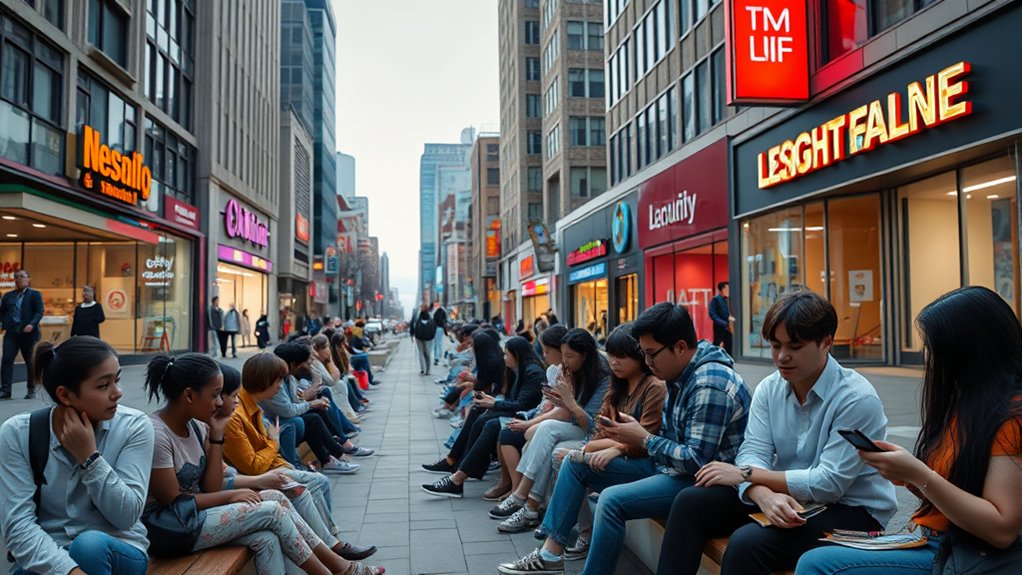The idea that nobody wants to work anymore is a myth that ignores how values and priorities are changing. Today’s workforce seeks meaningful roles in healthcare, education, and social care, with more emphasis on work-life balance and flexible arrangements. Demographic shifts, economic factors, and technological advancements are also reshaping engagement. If you want to understand whether this shift is permanent or just a perception, you’ll find insightful details ahead.
Key Takeaways
- The belief that “nobody wants to work” oversimplifies; many workers prioritize meaningful roles, flexibility, and work-life balance.
- Demographic and societal shifts reveal changing worker values, with increased focus on health, social care, and inclusive workplaces.
- Remote and flexible work options have expanded, reflecting evolving preferences rather than a disinterest in employment.
- Labor participation remains below pre-pandemic levels due to economic, demographic, and structural factors, not a universal desire to avoid work.
- Younger generations value purpose, balance, and diverse environments, indicating a shift in work values rather than a decline in work motivation.
Analyzing the Myth of Decreased Willingness to Work

Many believe that fewer people want to work nowadays, but this perception oversimplifies a complex reality. The labor market is evolving rapidly, driven by technological shifts and changing societal values. Instead of a lack of desire, many workers are seeking different kinds of roles, like those in healthcare, education, or social care, which reflect a shift in priorities. Remote work is also transforming perceptions of employment, offering flexibility that appeals to diverse generations. Additionally, younger workers value work-life balance more than previous generations, influencing their engagement levels. Job displacement and skills obsolescence highlight a progression rather than a decline in motivation. The truth is, people still want to work; they just want different, more meaningful, and adaptable opportunities that align with today’s societal and technological changes. Broadening digital access is expected to be the most transformative driver of these shifts, enabling more diverse and flexible work arrangements worldwide. Moreover, innovations in remote collaboration tools are making it easier for workers to adapt to new work environments and expectations, fostering a sense of technological empowerment that encourages continued engagement. As digital literacy continues to improve across populations, more individuals are equipped to participate effectively in modern, flexible work settings. Furthermore, technological advancements are creating new job sectors and opportunities that did not exist a decade ago, further supporting the evolving nature of work. A growing body of research indicates that employee motivation is increasingly tied to meaningful work and personal growth rather than traditional job security.
Examining Current Labor Force Participation Trends

You should consider how changing workforce demographics, like an aging population, influence participation rates. Economic conditions, especially during recovery periods, also play a key role in whether people enter or stay in the labor force. Additionally, gender participation gaps continue to shape overall trends, revealing shifts in societal and economic dynamics. Current data shows that the overall labor force participation rate in April 2025 is 62.6%, reflecting ongoing demographic and economic influences. Moreover, the rise of AI-driven automation could impact future employment opportunities and workforce engagement.
Changing Workforce Demographics
The U.S. labor force participation rate has seen slight but notable changes in recent years, reflecting shifting demographics across age, gender, and socioeconomic groups. While the rate increased modestly to 62.6% in April 2025, it remains below the 2000 peak of 67.3%. Women’s participation is near its highest at 78.1%, but both genders are trending downward. Prime-age workers (25-54) maintain stable participation at around 83.6%. Variability exists across age, race, and education levels, influencing overall trends. Analyzing signs of spoilage in food can help consumers understand changes in food safety and freshness. Recognizing these demographic shifts can also provide insight into labor market trends and employment patterns, especially considering how narcissistic behaviors may influence workplace dynamics and employee engagement. Additionally, understanding home organization strategies can contribute to better work-life balance and mental well-being, especially as many individuals spend more time at home due to shifting work habits. Furthermore, technological advancements are also impacting how workers engage with their roles and adapt to new work environments.
Impact of Economic Conditions
Economic conditions play a significant role in shaping current labor force participation trends, as shifts in the economy influence whether people enter or exit the workforce. The US participation rate stands at 62.6% in April 2025, slightly above March but below pre-pandemic levels. Economic downturns, like recessions or shocks such as COVID-19, cause drops in participation, with the rate falling from 63.3% in early 2020 to 60.1% during the pandemic. Even as the economy recovers, participation remains below the 67.3% peak in 2000. Factors like an aging population, educational enrollment, and discouragement during downturns also impact these trends. Additionally, labor market dynamics such as changing job availability and wages influence individual decisions about workforce engagement. Overall, recent modest increases reflect ongoing economic adjustments rather than mass withdrawal, highlighting the influence of economic conditions on workforce engagement. The current labor force participation rate also reflects ongoing demographic shifts, such as the aging population, which has contributed to the overall decline in active workforce engagement over time.
Gender Participation Gaps
Despite ongoing declines in overall labor force participation, gender gaps continue to shape current workforce trends. Women’s participation stands at 57.5%, nearly half of the labor force, yet remains below its 2000 peak by 2.9 percentage points. Men’s rates have declined more sharply, dropping 7.4 points from their peak. The participation gap narrows as both genders decline, but disparities persist, especially among those with less education. Higher education boosts women’s engagement, reaching 70% for those with a bachelor’s degree or higher. Parental status also influences women’s involvement; those with older children participate more than those with younger ones. The table below highlights key participation differences:
| Education Level | Men (%) | Women (%) |
|---|---|---|
| No high school diploma | 59.4 | 34.3 |
| Bachelor’s degree or higher | — | 70 |
| Less than high school diploma | — | 34 |
This persistent participation gap underscores ongoing demographic and societal influences on workforce engagement across genders.
How Demographics and Social Changes Influence Work Attitudes

Demographics and social changes are reshaping how people view work, influencing attitudes, expectations, and workplace behaviors. You’ll notice a shift toward valuing diversity, equity, and inclusion, with many workers prioritizing representation of different races, ethnicities, and genders. The workforce is increasingly diverse, with Millennials and Zoomers bringing fresh perspectives and tech skills. Age and education profoundly impact job satisfaction and motivation, highlighting generational differences in work ethic and expectations. Women, for example, tend to value inclusive environments more. Additionally, there’s a rising call for workplaces to foster a welcoming culture that reflects evolving social values. Understanding these demographic and social shifts helps you manage a more dynamic, inclusive, and adaptable workforce.
Demographic and social shifts are driving diversity, inclusion, and evolving workplace values for a more adaptable workforce.
- Diversity and inclusion are key priorities for many workers
- Generational differences shape attitudes toward work and balance
- Age influences expectations, motivation, and job satisfaction
- Women tend to value inclusive workplace cultures more
- Workforce diversity is expected to increase, shaping future workplaces
The Role of Economic Conditions and Policy in Shaping Participation

Recent trends in labor force participation reveal how economic conditions and policies directly influence whether people choose to work. Despite a low unemployment rate of around 3.5%, participation remains below pre-pandemic levels, showing economic uncertainty and structural factors matter. Policies like expanded benefits during COVID-19 temporarily reduced incentives, but tightening eligibility nudges participation upward. Regional job availability and wage stagnation also shape engagement, as shown below:
| Factor | Impact on Participation |
|---|---|
| Social safety nets | May discourage immediate return to work |
| Wage growth | Influences cost-benefit analysis of working |
| Policy adjustments | Encourage or suppress labor market entry |
| Job quality and benefits | Drive decision to participate or withdraw |
Additionally, the availability of retirement planning options and strategies can influence an individual’s decision to stay in the workforce or retire early, especially amidst economic shifts. For example, the perceived financial security provided by retirement accounts can lead some to exit the workforce sooner. Moreover, understanding the economic environment helps clarify how external factors impact employment choices. These elements highlight how economic shifts and policy choices influence whether you work or stay on the sidelines. Furthermore, the impact of labor market dynamics plays a crucial role in shaping employment decisions, as shifts in industry demand can either incentivize or discourage workforce participation. Additionally, the understanding of cookie categories helps explain how digital environments may impact perceptions and decisions related to employment trends.
International Perspectives on Employment Engagement

Across the globe, employee engagement levels are declining, signaling a shift in workplace motivation and organizational health. You’ll notice Europe struggles most, with only 13% engaged—just 10% in the UK. North America and some Asian countries fare better, reflecting cultural and economic differences. Managers, especially younger and female ones, are experiencing significant drops in engagement, impacting team dynamics. The decline links to poor management, weaker connections, and unclear organizational purpose. Emerging markets, like Brazil, show mixed results influenced by economic conditions. Demographics matter too—workers under 35 and women face notable engagement drops. These shifts threaten productivity, with an estimated $438 billion lost globally. Global engagement has declined for the first time in four years, marking a significant turning point in workplace dynamics. The decline also underscores the importance of employee motivation and how organizational culture can influence engagement levels. Regional cultural differences shape motivation—Management quality is vital for fostering engagement. Younger and female managers are most affected, highlighting the need for targeted leadership development. Organizational purpose impacts engagement, as employees seek meaningful work and alignment with company values. Demographics influence motivation, with younger workers and women showing the most significant declines. Additionally, organizational culture plays a crucial role in fostering or hindering employee engagement across different regions. Building a supportive and inclusive culture can mitigate some of these engagement challenges, especially when aligned with employee values.
Shifting Values: Flexibility, Education, and the Future of Work

You’re seeing how more workers prioritize work-life balance and flexible schedules over traditional roles. As the workforce values lifelong learning and digital skills, adapting to remote work becomes essential. These shifts are shaping the future of work, demanding new approaches from employers and employees alike.
Emphasis on Work-Life Balance
Work-life balance has become a central focus for employees seeking better well-being and job satisfaction. You recognize that 94% of workers see it as essential for overall health. When you maintain a healthy balance, your productivity increases by 21%, and job satisfaction rises—63% of balanced workers are more willing to go above and beyond. Remote and hybrid arrangements boost this balance, with 85% of remote workers feeling it improves their well-being. You might also notice that poor work-life balance impacts sleep and mental health, affecting your performance. Organizations that prioritize WLB see higher productivity and retention. Emphasizing flexibility benefits both mental health and job engagement, making work more fulfilling and sustainable.
- Improved productivity with balanced work routines
- Remote work enhances well-being for most employees
- Mental health benefits from flexible schedules
- Higher job satisfaction linked to work-life balance
- Organizations adopting WLB see better performance
Value of Lifelong Learning
Have you noticed how rapid technological advancements are transforming the way we work? AI, machine learning, and generative AI are reshaping job roles, making upskilling essential. The World Economic Forum predicts nearly half of your skills could be disrupted within five years. To stay relevant, organizations are emphasizing lifelong learning through personalized, on-demand training powered by AI tools. Traditional continuing education models are shrinking, with fewer microcredentials offered due to relevance concerns and administrative hurdles. Instead, institutions focus on aligning education with labor market needs, partnering with employers, and expanding workforce-relevant programs. Soft skills like adaptability and emotional intelligence are increasingly integrated into curricula. Lifelong learning is now a crucial strategy, helping you adapt to social, technological, and economic shifts while supporting personal growth and global progress.
Rise of Remote Work
The rise of remote work is reshaping traditional employment patterns, driven by technological advancements and evolving employee preferences. More jobs now offer remote or hybrid options, with three times more remote opportunities than in 2020. As of 2025, nearly 23% of US employees work remotely at least part-time, and hybrid roles have become stable. Fully remote job postings remain steady at around 6%, while in-office postings decline from 83% to 60%. Higher education boosts remote work adoption, with 42.8% of those with advanced degrees working remotely. Remote work improves work-life balance, increases productivity, and attracts many applicants. This trend is transforming industries, office spaces, and geographical work patterns, especially in rural areas and among senior professionals. Remote work is here to stay, shaping the future of employment.
Frequently Asked Questions
How Do Technological Advancements Impact Current Work Engagement Levels?
You see that technological advancements, like AI and flexible work tools, can boost engagement if implemented well. They help streamline tasks, foster innovation, and support remote or hybrid work, which employees value highly. However, if organizations lag in adoption or don’t provide proper upskilling, engagement suffers. When technology aligns with employee expectations and is used effectively, it can markedly increase motivation and productivity at work.
What Demographic Groups Are Most Affected by Participation Rate Changes?
Demographic differences dominate the discourse on participation rate shifts. You’ll notice that Black women lead among women, while Hispanic and Asian men boast the highest participation among men. Younger workers withdraw, while older adults stay longer, and those with higher education stay more engaged. You see that race, gender, age, and education intersect, shaping workforce participation. These diverse demographics drive dynamic changes in who’s stepping up and staying in the workforce.
How Do Cultural Differences Influence Global Attitudes Toward Work?
You see, cultural differences shape how people view work worldwide. In individualistic cultures like the U.S., achievement matters most, while in collectivist societies like Japan, loyalty and harmony take precedence. Europeans prioritize work-life balance, whereas some Asian countries have traditionally long hours. These values influence attitudes, expectations, and job satisfaction, meaning you need to understand local norms to manage teams effectively, foster inclusivity, and adapt your leadership approach across diverse cultural landscapes.
What Specific Policies Have Successfully Increased Labor Force Participation?
Think of policies as keys opening potential in the workforce. You see, subsidized childcare and family leave remove barriers, making it easier for parents to work. Flexible schedules and inclusive cultures attract more talent, while training programs upgrade skills. Retirement incentives keep experienced workers engaged longer. When you combine these policies, you create a pipeline of motivated workers enthusiastic to contribute, boosting overall participation and strengthening the economy.
How Might Future Economic Shifts Alter Employment Willingness?
Future economic shifts will likely influence your willingness to work by creating new job opportunities in green tech, AI, and healthcare, which may motivate you to stay engaged. However, economic uncertainties like inflation or slower growth could make you cautious about job stability. If you adapt by learning new skills and embracing emerging sectors, you’ll find more reasons to participate actively in the workforce, even amid changing economic conditions.
Conclusion
So, as you see, the idea that nobody wants to work anymore is more myth than reality. Today’s shifts in values, economic factors, and demographics shape how people engage with work, much like a modern Renaissance. Instead of blaming a lack of effort, consider how flexibility and purpose drive motivation. Remember, even in the age of dial-up internet, folks still sought meaningful work—it’s just the landscape that’s changing, not the desire to contribute.









